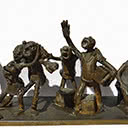Te Hei A Chieftainess of the Ngati Raukawa Tribe - As Rembrandt Would Have Painted the Maori
42 x 37 cm
est. $500,000 - 800,000
Provenance:
Dame Kiri Te Kanawa Collection
label affixed verso
Long Term Loan, Auckland Art Gallery, Toi o Tamaki
Exhibited:
John Leech Gallery, Auckland, 1953
Cordy's, Auckland, 7 May 1971
Charles F Goldie: Revealing the Painter and the Subject Auckland Art Gallery, Toi o Tamaki, March 2016 - February 2018
Long Term Loan, Auckland Art Gallery, Toi o Tamaki
Illustrated:
NZ Herald, 23 June 1971
p. 289 C F Goldie, His Life & Painting, Alister Taylor & Jan Glen, 1977
NZ Art Auction Records, 1969 - 1972, Henry Newrick,
Newrick Associates, Wellington
This portrait from Goldie's late period depicts Te Hei of Ngāti Raukawa, identified by the New Zealand Herald in 1907 as a subject for whom he has a great fondness. When he first painted her in 1906, Te Hei was an elderly woman whose visage, presented through the lens of Goldie's paintbrush, already seemed to bear the weight of time, grief and imminent loss. As if in affirmation of this, an earlier work was entitled Touched by the Hand of Time. This late portrait is a beautifully distilled expression of Goldie's original pathos of mortality and fragility for his sitter; magnified and at the same time bearing it's most essential qualities after a period of more than thirty years.
Though her eyes are partially obscured by shadow, Te Hei's gaze transcends the picture plane with compelling intensity. Her wrinkles are deep grooves, etched unto her face as if carved. Particularly striking is the impressionistic light applied to the surface of the portrait. By this point, Goldie's technique was no longer a formally restrained means to the end of photographic fidelity; he was apparently striving for something more fluid and spiritually-charged. The period surrounding the production of this work may be thought of as something of a personal and artistic self-reckoning for Goldie, who had by this time been battling with his own ill health for a number of years.
Through the repetitious act of returning to Te Hei, a beloved subject he had painted over the course of several decades, the artist was forging an alternative rhythm for himself, one which lay somewhere between the spheres of classical formalism, impressionism and his own experience of Māori culture. In doing so, intentionally or otherwise, he also appears to have been expressing something of his own journey.
For more information on this piece, please download this PDF (114KB)





